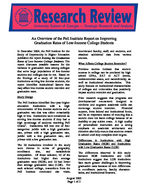An Overview of the Pell Institute Report on Improving Graduation Rates of Low-Income College Students
In December 2004, the Pell Institute for the Study of Opportunity in Higher Education published the report Raising the Graduation Rates of Low-Income College Students. The report discusses possible reasons for the variance in graduation rates among colleges that serve large populations of low-income students and colleges that do not. Based on the findings of a study of 20 four-year institutions serving low-income students, the report identifies institutional factors that may affect low-income student retention and graduation rates.
Study Design
The Pell Institute identified four-year higher education institutions with a high concentration of low-income students and a graduation rate that was either remarkably high or low. Institutions were considered as serving low-income students if they had a high percentage of students receiving Pell Grants1. Institutions fell into one of four categories: public with a high graduation rate, private with a high graduation rate, public with a low graduation rate, and private with a low graduation rate.
The 20 institutions involved in the study were diverse in terms of geography, enrollment size, and racial/ethnic composition. Of those selected, 10 of the institutions had higher than average graduation rates (HGR), and 10 had lower than average graduation rates (LGR). For each selected college, researchers from the Pell Institute conducted site visits,
interviewed faculty, staff, and students, and obtained additional data from various sources.
What Affects College Student Retention?
Previous studies indicate that student success in college can be predicted by high school GPAs, SAT or ACT scores, socioeconomic status, and race/ethnicity, as well as institutional characteristics. This study focuses on institutional characteristics of colleges and universities that positively impact student retention and graduation.
Prior research suggests that programs and developmental coursework designed to reinforce and augment academic skills can encourage student retention. Financial support, from federal and institutional funds, can be an important means of ensuring that a student does not leave college because of an inability to pay tuition costs. A high quality of personalized instruction and a strong emphasis on academic advisement and direction also help ensure that students remain in school until they complete their degree.
Differences in Institutions with High Graduation Rates (HGR) and Institutions with Low Graduation Rates (LGR)
The differences observed in this study between HGR institutions and LGR institutions suggest that LGR institutions face much greater challenges in improving graduation rates because of core differences in enrollment patterns, faculty characteristics, and institutional finances.
August 2005 Page 1 of 3
Key distinctions between HGR and LGR institutions are that HGR institutions:
have higher enrollments of full-time students;
are more likely to attract students of traditional college age (18 24 years of age);
have greater percentages of full-time faculty;
have lower student/faculty ratios;
have higher expenditures per FTE student;
and rely on tuition to cover expenditures less than LGR institutions.
HGR institutions are more likely to enroll students who are academically advantaged upon college entrance and receive financial aid in the form of institutional grants.
Common Characteristics Among Institutions with High Graduation Rates (HGR)
The HGR institutions had common characteristics which may help explain their higher graduation rates:
intentional and ongoing academic planning for students;
small classes;
special programs for low-income students that provide guidance and academic support;
dedicated, full-time faculty, who are accessible and involved in students' lives and academic careers;
a degree of education innovation, including offering freshman orientation courses;
developmental education to improve basic skills needed for student success;
geographic isolation that creates a strong sense of community and belonging for students at the institution;
residential life that provides a focal point for students' social life and keeps students on campus;
shared values, such as religion, or race/ethnicity, among students and faculty;
modest selectivity by institutions in order to seek students with a likelihood of completing college;
financial aid offered to high achievers, to encourage their attendance at the institution;
and attention to and focus on institutional policies to improve student retention.
Not every HGR institution demonstrated each of the above elements, nor is there enough evidence that these factors explain high graduation rates. These observations, however, offer a starting point for further research on the reasons low-income students graduate at lower rates than other college students.
These findings suggest that improving graduation rates of low-income students requires more than simple policy "tweaking." The study suggests it may be difficult for LGR institutions to achieve results similar to HGR institutions without systematic, state-level attention to the core elements of university instruction, finance, and community structure.
The research of the Pell Institute adds important findings to our understanding of factors affecting student graduation rates. Institutions with high graduation rates
August 2005 Page 2 of 3
actively intervene with students' academic planning and offer developmental courses to many freshmen. They also exercise selectivity in admissions in order to attract students likely to complete college. Finally, they offer students a sense of community and belonging, through geographic locations or on-campus communities.
1 Pell Grant data for the study were obtained from the U.S. Department of Education, National Center for Education Statistics. Institutional graduation rates were obtained from a survey of the National Collegiate Athletic Association.
Susan Walker Office of Strategic Research and Analysis Board of Regents of the University System
of Georgia 270 Washington St., SW Atlanta, Georgia 30334 Susan.Walker@usg.edu
August 2005 Page 3 of 3
